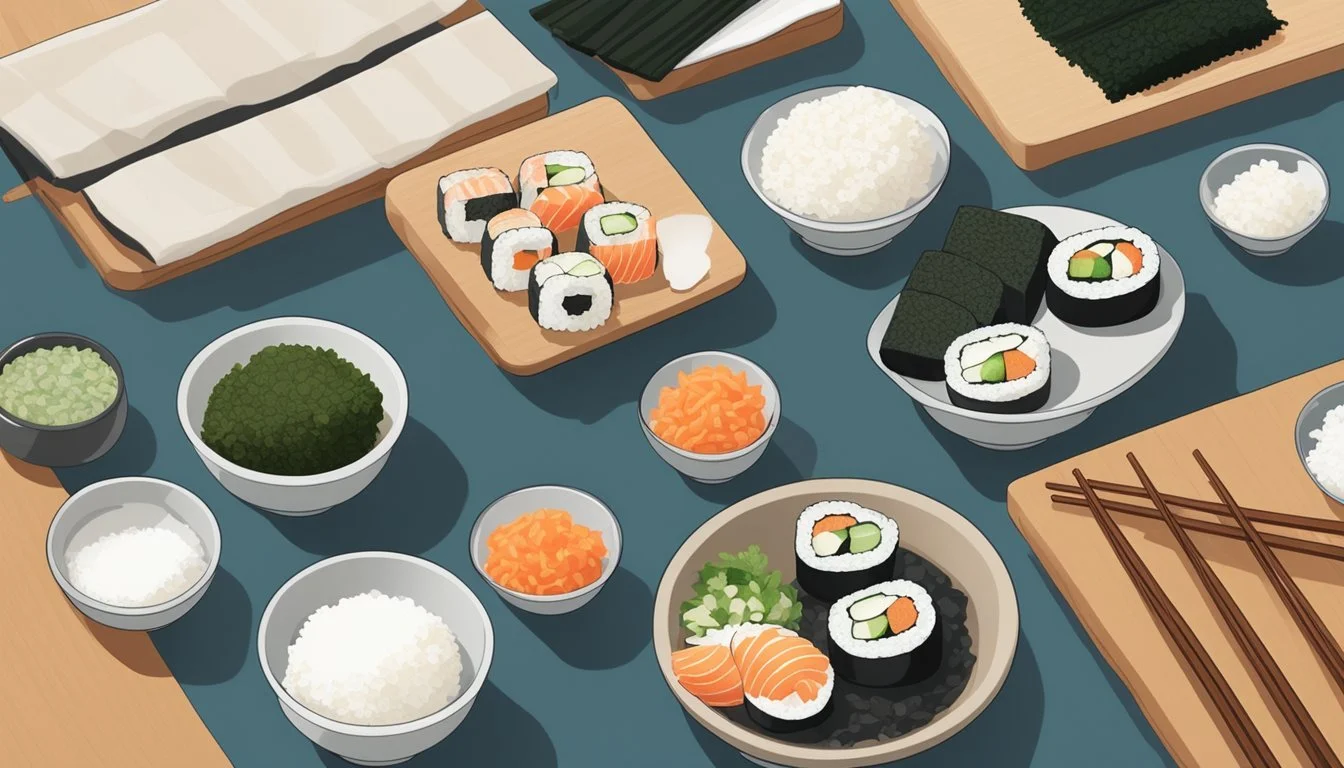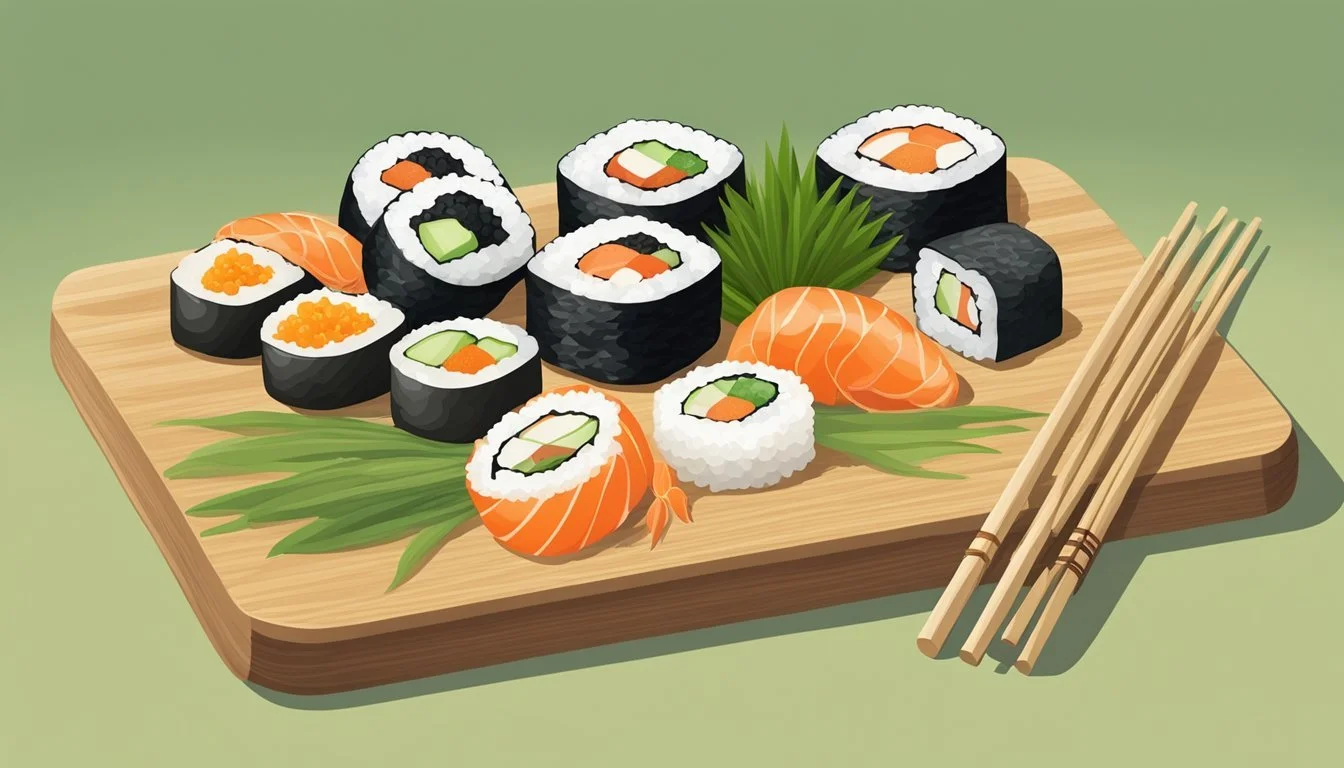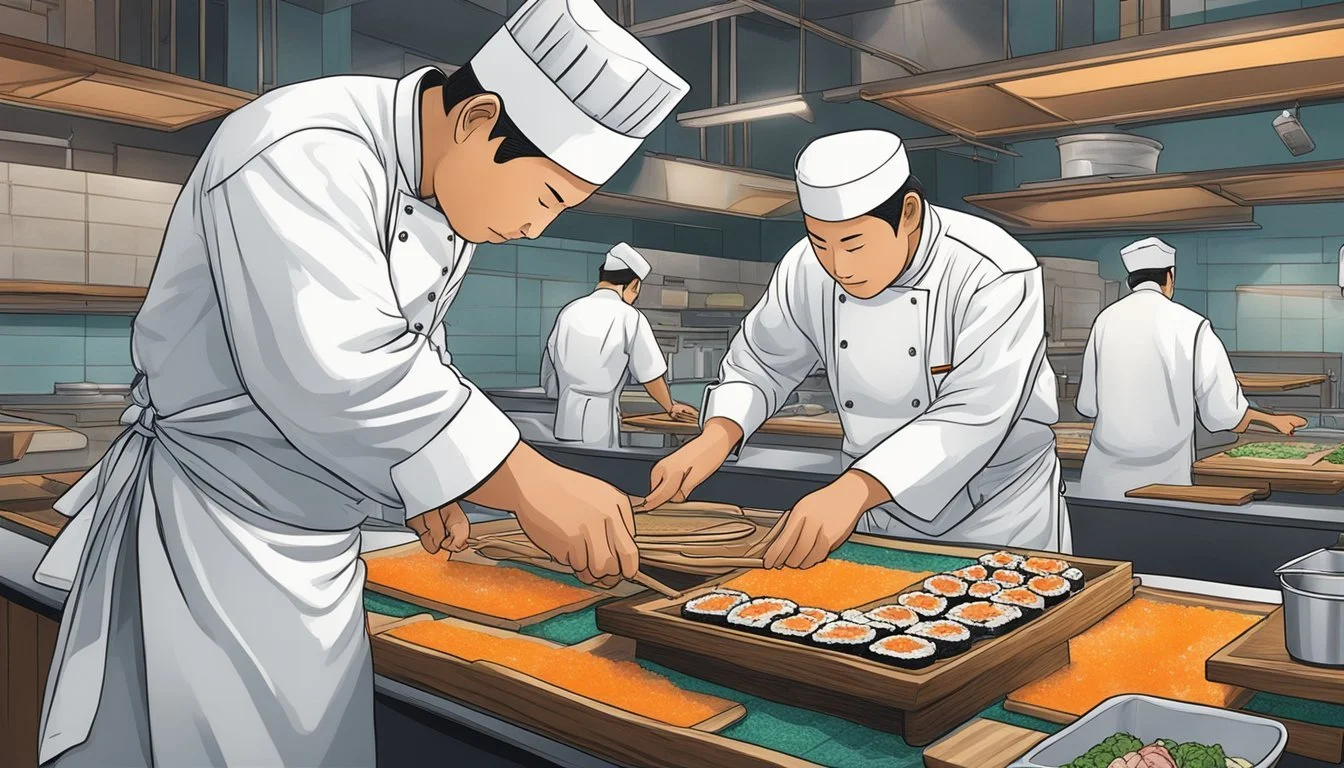How to Make Flavorful Crab Roe Sushi from Scratch
A Step-by-Step Guide
Crafting flavorful crab (What wine goes well with crab?) roe sushi (What wine goes well with sushi?) begins by selecting the finest ingredients to create a dish that is both visually stunning and tantalizing to the taste buds. Sushi, a traditional Japanese delicacy, has long incorporated an assortment of seafood, with crab being a favored choice for its sweet, succulent meat. Crab roe, or kani miso, adds a unique richness and depth of flavor that enhances the overall taste profile of the sushi.
The process of making crab roe sushi from scratch involves careful preparation and an eye for detail. It is an art that requires meticulously cooked sushi rice, seasoned just right to complement the delicate flavors of the crab. Mixing the roe with the additional ingredients is a delicate balance, ensuring each component shines through without overpowering the others.
For connoisseurs and newcomers alike, the allure of homemade sushi lies in the freshness of the assembly. With each bite, the combination of sticky rice, tender crab, and the robust flavor of roe creates a culinary experience that captures the essence of traditional sushi while tantalizing the modern palate. Whether enjoyed as a luxurious treat or part of a gourmet spread, crab roe sushi promises an unforgettable foray into the world of sophisticated flavors.
Sourcing Ingredients
For the best crab roe sushi, one must carefully select the right ingredients. Quality crab, premium nori, and the proper sushi rice are pivotal for creating an authentic sushi experience.
Selecting Quality Crab Meat
When sourcing crab meat for sushi, one should look for fresh, real crab. Live crabs or pre-cooked lump crab meat are suitable for an authentic flavor. Imitation crab meat, though budget-friendly, won't impart the same richness or texture as real crab. It's made from surimi (processed white fish What wine goes well with white fish?) and lacks the delicate taste of true crab.
Choosing the Right Nori
The choice of nori is crucial. Look for nori seaweed sheets that are a deep green, almost black, with a shiny, lustrous surface. Quality nori should have a crisp texture that will not only hold the sushi together but also contribute a subtle, briny flavor. Nori that is too brittle or with a dull color may indicate staleness and can detract from the overall taste of the sushi.
Best Rice for Sushi Making
Sushi rice is the cornerstone of any sushi dish. One should opt for short-grain rice specifically labeled as sushi rice. The grains have the ideal balance of starchiness needed to stick together yet retain individual grain texture when properly cooked. Rinse the rice until the water runs clear before cooking to remove excess starch and achieve the perfect consistency for sushi making.
Preparing the Components
To ensure the perfect balance of flavors and textures in your crab roe sushi, one must meticulously prepare the rice, crab salad filling, and accompanying vegetables and toppings.
Cooking and Seasoning the Rice
Begin by cooking Japanese short-grain rice until it is sticky and fluffy. Once cooked, gently fold in a seasoned mix of rice vinegar, sugar, and salt, taking care to not mash the grains. The seasoned rice should be glossy and have a slightly tangy taste to complement the flavors of the sushi.
Making the Crab Salad Filling
For the crab salad filling, combine shredded imitation crab meat with a spicy mayo made from mixing Kewpie mayonnaise with Sriracha sauce to taste. The Japanese mayonnaise adds a richer, slightly sweet profile, while the Sriracha provides a kick of heat. Ensure the crab is well-coated but not overly wet.
Cutting Vegetables and Toppings
Slice vegetables such as cucumber, bell pepper, and avocado into long, thin strips. These should be crisp and fresh to add a crunch to the sushi. Optionally, one can also prepare a sprinkling of toasted sesame seeds and thin carrot sticks for additional garnishes. These toppings offer both visual appeal and a complex texture to the dish.
Assembling the Sushi
Proper assembly is crucial for crafting an exemplary sushi roll. The reader should pay careful attention to the layout of ingredients and the technique used for rolling with a bamboo mat for a snug, well-shaped sushi roll.
Laying Out Ingredients
Before the reader begins rolling, they must prepare their workspace by laying out all necessary components. On a clean, flat surface, the reader should place their bamboo mat, also known as a makisu, and cover it with plastic wrap to prevent sticking. Next, they should have their nori wrap at the ready along with a bowl of water to dampen fingers, as sushi rice is quite sticky. The filling, which includes the flavorful crab roe mixture, should be prepared in advance and set beside the bamboo mat for easy access.
To begin, they'll place a sheet of nori shiny side down on the bamboo mat. Then, they'll gently spread a thin, even layer of sushi rice over the nori, leaving about one inch of space at the top. He or she will then add a line of the crab roe filling along the bottom edge of the rice-covered nori, being careful not to overfill.
Rolling with Bamboo Mat
The sushi roll comes together with a careful yet assertive rolling technique:
Start the Roll: The reader starts at the bottom edge of the nori, gently lifting the bamboo mat with thumbs while holding the fillings in place with other fingers.
Roll Tight: They then proceed to roll the mat over the filling, tucking the leading edge of the nori to encase the fillings.
Shape with Pressure: As they continue to roll, slight pressure is applied along the length of the mat to ensure that the sushi is compact and the rice adheres to the filling and itself.
Seal the Sushi: Once the roll is complete, the reader should wet the exposed strip of nori at the top and roll the sushi forward to seal the edge.
The reader can then unwrap the bamboo mat and will be left with a completed sushi roll, ready to be sliced into individual pieces with a sharp, wet knife to prevent sticking.
Adding Flavorful Condiments
For the ultimate crab roe sushi experience, a chef skillfully incorporates a variety of condiments to enhance the dish’s complex flavors. Here’s how they elevate the taste profile:
Soy Sauce: A classic sushi accompaniment, soy sauce provides a salty umami kick that complements the rich taste of crab roe. Use sparingly to avoid overpowering the delicate roe flavors.
Spicy Mayo: Often made by mixing mayonnaise with sriracha, this creamy sauce adds a smooth, spicy edge. Chefs drizzle it over the sushi for a visually appealing finish and a burst of heat.
Wasabi: This potent Japanese root is grated into a fine paste, offering a sharp, refreshing heat. It’s traditionally placed between the rice and fish, allowing diners to savor the tingling sensation with each bite.
Ginger: Pickled ginger serves as a palate cleanser. Its sweet, tangy flavor helps to reset taste buds in between bites of the rich, savory roe.
Condiment Flavor Note Serving Suggestion Teriyaki Sweet and tangy Glazed atop or served as a dipping sauce Eel Sauce Sweet, umami-rich Drizzled over sushi for a hint of smokiness Spicy Mayo Creamy with a kick Drizzled or dolloped on top for a spicy flavor boost Wasabi Pungent and sharp A small amount placed under the roe to awaken the senses Ginger Tangy and palate-cleansing Served on the side for refreshing bites
A thoughtful approach to condiments not only adds dimension to the sushi but also respects the main ingredient. Chefs balance each addition to ensure the star—crab roe—is highlighted, not overshadowed.
Cutting and Presentation
The key to a stunning sushi presentation lies in precise cutting and thoughtful arrangement. The use of the right tools and techniques ensures each slice of Crab Roe Sushi is visually appealing and maintains its integrity from the cutting board to the plate.
Using the Right Knife
For cutting sushi, a sharp, non-serrated knife is essential. One should use a blade specifically designed for sushi-making, such as a sashimi knife, to achieve clean cuts. The knife should be wetted with a little water or rice vinegar before slicing to prevent sticking, and one should clean the blade between cuts to ensure each piece is neat and tidy.
Arranging for Maximum Appeal
Once cut, the pieces should be artfully arranged on the plate. The aim is to showcase the crab roe's vibrant color and the sushi's structure. Here's a suggested arrangement:
Color Contrast: Place the sushi on a contrasting-colored plate to make the orange hue of the crab roe pop.
Odd Numbers: Arrange pieces in odd numbers, as they are more aesthetically pleasing.
Spacing: Give each piece enough space to stand out, but keep them close enough to create a sense of unity.
Garnish: Use garnishes sparingly to complement the sushi without overwhelming it.
Serving Suggestions
When one masters the art of preparing crab roe sushi, presenting and preserving it in the ideal way is crucial to enhance the experience. The right sides, drinks, and storage methods maintain the sushi's integrity and flavor.
Pairing with Sides and Drinks
One should offer crab roe sushi as an appetizer at gatherings or as part of a larger meal. It pairs excellently with:
Miso Soup: A traditional starter that complements sushi with its umami flavors.
Pickled Ginger: Served on the side for its palate-cleansing properties.
In terms of beverages, for those who consume alcohol, a crisp Sake or a light Japanese beer enhances the flavors of the sushi. For a non-alcoholic option, Green Tea is a classic and refreshing choice.
For a party or a casual get-together, crab roe sushi can be a sophisticated yet approachable option even for beginners in Japanese cuisine. Invite friends to enjoy as a snack or part of a varied selection of dishes.
Storing Leftover Sushi
If there are leftovers, it’s important to store the sushi properly to maintain its quality:
Place the sushi in an airtight container.
Refrigerate promptly at a consistent temperature.
Leftover sushi should be enjoyed within 24 hours to ensure freshness and optimal taste. It is not typically recommended to freeze sushi as it can significantly deteriorate the quality of the ingredients, particularly the texture of the rice and the delicate crab roe.
Advanced Techniques
In mastering the art of sushi with crab roe, there are advanced techniques that can elevate the dish to a professional level. Attention to detail and precision in crafting nigiri and sashimi are crucial, as is the creativity in experimenting with variations of the sushi roll.
Crafting Nigiri and Sashimi
Nigiri involves a slice of raw seafood atop a molded block of sushi rice. For a decadent twist, chefs may place a thin layer of crab roe on top of the nigiri, adding a burst of umami and a visually appealing orange hue.
Shape a small mound of rice with gentle pressure to form an oblong base.
Take a slice of seafood, like salmon or tuna, and dab a small amount of wasabi on one side.
Place the slice on the rice, wasabi side down, with a delicate layer of crab roe atop the seafood.
Sashimi, on the other hand, is the art of slicing raw fish to be enjoyed without rice. When incorporating crab roe, it's essential to maintain the integrity of the fish's texture.
Slice the fish into uniform, thin pieces, ensuring each slice is free of sinews or imperfections.
Serve the sashimi with a side of crab roe, allowing diners to experience the roe's richness with each bite of the pristine fish.
Experimenting with Variations
When creating homemade sushi rolls using crab roe, consider enhancing classic recipes with innovative twists.
For a Spicy Kani Roll:
Replace traditional kani with a mixture of crab meat and tempura for added crunch.
Mix crab roe with a spicy mayo sauce and layer it into the roll for a fiery kick.
For a California Roll:
Inside the roll, incorporate creamy avocado and cucumber with the crab roe for a rich yet refreshing bite.
Roll the exterior in tobiko to complement the crab roe's flavor and add textural contrast.
For a Spicy California Roll:
Integrate the spicy crab roe mix into the classic California roll components.
Balance the heat with soothing slices of cream cheese to create a complex flavor profile.
These advanced techniques, when executed with precision and creativity, can transform simple sushi into culinary works of art that showcase the versatile and indulgent flavors of crab roe.
Health and Safety Considerations
When making crab roe sushi, chefs should prioritize health and safety by following proper food handling practices. Fresh crab, including varieties like Dungeness, should be purchased from reputable suppliers and verified as safe for raw consumption. Chefs must ensure that the crab is thoroughly cooked to an internal temperature of 145°F, using a pot or steamer, to kill any potentially harmful bacteria.
For sushi enthusiasts who are vegetarian or prefer not to use real crab meat, imitation crab offers a safer alternative as it is typically pre-cooked and made from surimi, a processed seafood product. However, vegetarians should verify the ingredients for compatibility with their dietary restrictions.
Handling Crab Roe and Meat:
Ensure freshness and quality by sourcing from trusted suppliers.
Maintain proper hygiene and cleanliness during preparation.
Cooking Temperature:
Cook real crab meat to an internal temperature of 145°F for safety.
Imitation crab meat is precooked and chilled before use.
Safety for Vegetarians:
Confirm that imitation crab aligns with vegetarian dietary requirements.
Equipment:
Utilize clean kitchen tools and surfaces to prevent contamination.
Chefs must be vigilant about cross-contamination; all equipment, including knives and cutting boards, should be sanitized before use. In the case of fresh crab, particular attention must be given to keeping raw and cooked foods separate to avoid any health risks.
Demystifying Sushi Terminology
In the world of sushi, certain terms are essential to understand the components and variations of this Japanese culinary art.
Understanding the Language of Sushi
Navigating sushi terminology begins with learning the basic elements and common variations of sushi rolls. The foundation of most sushi is sushi rice, which is typically seasoned with vinegar, sugar, and salt. Here's a breakdown of sushi-specific terms related to crab roe sushi:
Nori: This is the dried seaweed sheet used to wrap around the sushi rice and fillings.
Spicy Crab Roll: A sushi roll containing crab or imitation crab that's been mixed with spicy mayonnaise and other seasonings.
Spicy Crab Salad: A mix of crab, mayonnaise, and spicy seasonings that can be used as a filling or topping for sushi.
Spicy Crab Sushi Roll: Similar to the spicy crab roll, however, the term often implies additional ingredients such as avocado, cucumber, or other fillings.
Kani Salad: A salad made with shredded imitation crab and often mixed with cucumber, mango, and a creamy dressing.
Rice on the Outside: This term refers to sushi rolls where the rice is on the exterior, with the nori on the inside, such as in a California roll.
Fish Roe: Fish eggs, which can be from various species, are often used as a garnish or ingredient in sushi for their flavor and texture.
Soy Paper: An alternative to nori made from soybeans, used to wrap sushi for those who prefer a different taste or have dietary restrictions.
Masago: This is the roe (eggs) from the capelin fish, often used as a topping for its crunchy texture and salty ocean taste.
Mango: A non-traditional ingredient that adds sweetness to sushi rolls, such as in some kani salads.
Hot Sauce: A spicy condiment that can be mixed with mayo to create a sauce for spicy crab rolls.
When discussing "crab roe sushi," it's important to note that "roe" refers to the eggs or fish roe used in sushi. "Crab roe" specifically could refer to the eggs harvested from crabs, adding a rich, umami flavor to the sushi. This ingredient, however, is not as commonly used as masago, tobiko (flying fish roe), or ikura (salmon roe). In the context of the sushi menu, if "crab roe" is mentioned, it might be indicative of a specialty sushi item featuring actual crab eggs as a distinguished element.
Responsible Sourcing and Sustainability
When creating crab roe sushi, chefs have a responsibility to source their ingredients sustainably. The ocean's health hinges on choices they make; therefore, sustainable practices are essential for the longevity of seafood supplies. They commonly select crab species that meet sustainability standards, ensuring that their harvest does not detrimentally impact ocean ecosystems.
Sustainable Sourcing Practices:
Research: Chefs should investigate and source from fisheries that are certified by reputable commissions or organizations that promote sustainable fishing.
Traceability: It is important to track where and how the crab roe was harvested to affirm its sustainability.
Seasonality: They may consider the season when specific crab species are most sustainable to harvest.
Here are some recommendations for selecting sustainable crab roe:
Opt for crab roe that is certified by recognized sustainable seafood programs.
Prioritize local suppliers who engage in responsible fishing practices.
Evaluate the sustainability of the fishery by considering factors such as bycatch rates and management practices.
By conscientiously sourcing ingredients, chefs make a positive contribution to ocean conservation. Consumers can support this effort by choosing to patronize establishments that are transparent about their sustainable sourcing practices. This collective effort can lead to a greater variety of seafood being available for future generations.









